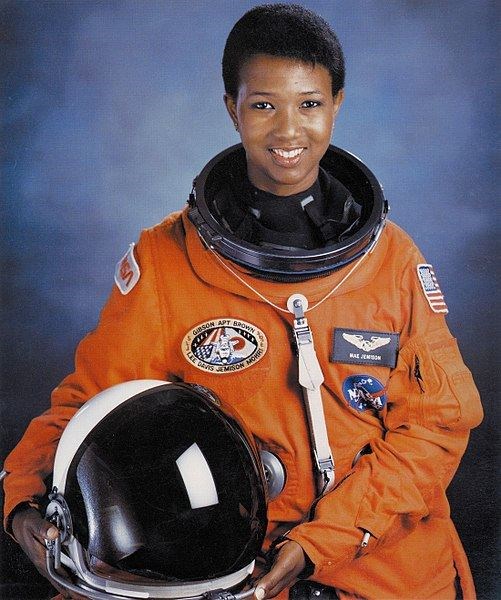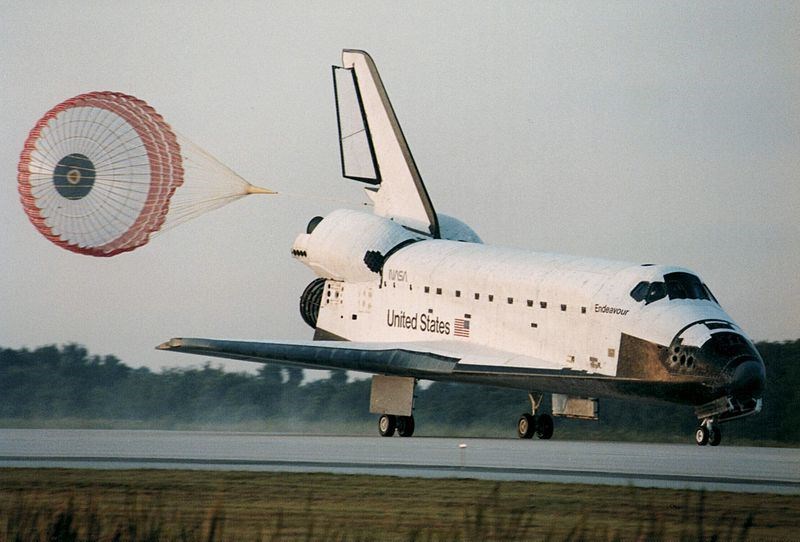“Don’t let anyone rob you of your imagination, your creativity, or your curiosity. It’s your place in the world; it’s your life. Go on and do all you can with it, and make it the life you want to live.” – Mae Jemison

NASA [Public domain]190 hours in space. Mae Jemison spent many hours in space for someone who thought she could never get there. From a young age, Jemison was interested in science, whether that was watching Star Trek or working with medicine. Her parents, Dorothy and Charlie Jemison, along with her teachers always pushed her to be involved in science. Mae Jemison continued to study after graduating high school to get a scholarship to Stanford University: “During her years there, she found time to expand her horizons by visiting and studying in Cuba and Kenya and working at a Cambodian refugee camp in Thailand” (“Mae Jemison.” Notable Women Scientists). When Jemison was working as a medical student, she realized that she couldn’t continue with what she was doing. Mae Jemison found out that she could apply to be a part of NASA and possibly go to space. As an African American woman, she never thought that the job would be possible, as only seeing Caucasians go into space. Jemison had to work extra hard to be able to pursue her dream. When she got back from space, she wanted to show other kids that they can achieve their dreams even if it seems impossible. Mae Jemison is a hero because she is a pioneer by becoming the first African American woman to go to space, and because of her motivation for herself and others to overcome adversity.
Being the first female African American to go to space, Mae Jemison was a pioneer and made history. Having doubts of her acceptance, Mae Jemison realized that she wanted to apply to be a part of NASA: “When Jemison was chosen on June 4, 1987, she became the first African American woman ever admitted into the astronaut training program. After more than a year of training, she became an astronaut with the title of science-mission specialist, a job which would make her responsible for conducting crew-related scientific experiments on the space shuttle” (“Mae Jemison.” Notable Women Scientists). Jemison became a pioneer when she was chosen to go to space. When she applied for NASA, Jemison had been working in the medical field and had little knowledge about space. When Jemison got chosen for the job she constantly trained so she could take advantage of her opportunity, being “the first Black woman ever to receive that honor” (“Mae Jemison.” Astronomy and Space). In 1987, the idea of a African American women going up to space was unheard of, as logging 190 hours in space had never been done by a woman of her race. She was able to train to show her peers that she could contribute the same amount as them. Since science was always so important to Jemison, she had always wanted to help others. In her medical career, she traveled to Kenya and Cuba to study. Even though she had gotten a scholarship to work with medicine, she dropped it so she could train to be a a part of NASA. Her passion for travel and adventure contributed to when she was responsible for conducting experiments on the space shuttle. To be responsible for this job was hard, but she knew she had a standard to uphold for being the first black woman to ever travel to space. As a pioneer, her reputation created pressure for Jemison to impress those around her. Mae Jemison took advantage of her opportunity to go to space, but along with the pressure, she had to overcome obstacles.
 Space Shuttle EndeavorNASA [Public domain]When Jemison got back from space, her motivation and positive outlook made her want to show others how to pursue their dreams while overcoming adversity. Knowing she would have a hard time fitting into the science field, “Jemison spent considerable time in her school library reading about all aspects of science, especially astronomy. During her time at Morgan Park High School, she became convinced she wanted to pursue a career in biomedical engineering, and when she graduated in 1973 as a consistent honor student, she entered Stanford University on a National Achievement Scholarship” (“Mae Jemison.” Notable Women Scientists). Jemison knew that she would be discouraged in the science community. Because of this she had to study extra hard in school to be able to fit in. She did not want to give up on her lifelong dream of being involved in science. The adversity she had to overcome held Jemison back from easily getting jobs. She had to work twice as hard as the other students to get a scholarship to Stanford University. After Mae Jemison completed her space journey, “She also founded her own company, the Jemison Group, which seeks to encourage a love of science in students and bring advanced technology to schools around the world. She is a strong advocate for science and established an international science camp for high school students” (Redd). After space, Jemison’s motivation encouraged her to show kids what they can do even when they are discouraged. Creating her own group is her way of showing them that. The Jemison group is teaching kids about science in a fun way without being discouraged. Having a hard time getting accepted into NASA herself, she wants to give kids motivation so they don’t have to be alone in a hard time like she was in. Jemison is showing kids that they aren’t alone while overcoming adversity. Because of her actions and perseverance in space, “Jemison has become something of a celebrity. She is considered, naturally, a role model for Black youth” (“Mae Jemison.” Astronomy and Space). Kids look up to Mae Jemison. She is a role model for them because she has shown them that they can do the unexpected. Realizing how she had to overcome obstacles, Mae Jemison got back from space wanting to show others how they could too.
Space Shuttle EndeavorNASA [Public domain]When Jemison got back from space, her motivation and positive outlook made her want to show others how to pursue their dreams while overcoming adversity. Knowing she would have a hard time fitting into the science field, “Jemison spent considerable time in her school library reading about all aspects of science, especially astronomy. During her time at Morgan Park High School, she became convinced she wanted to pursue a career in biomedical engineering, and when she graduated in 1973 as a consistent honor student, she entered Stanford University on a National Achievement Scholarship” (“Mae Jemison.” Notable Women Scientists). Jemison knew that she would be discouraged in the science community. Because of this she had to study extra hard in school to be able to fit in. She did not want to give up on her lifelong dream of being involved in science. The adversity she had to overcome held Jemison back from easily getting jobs. She had to work twice as hard as the other students to get a scholarship to Stanford University. After Mae Jemison completed her space journey, “She also founded her own company, the Jemison Group, which seeks to encourage a love of science in students and bring advanced technology to schools around the world. She is a strong advocate for science and established an international science camp for high school students” (Redd). After space, Jemison’s motivation encouraged her to show kids what they can do even when they are discouraged. Creating her own group is her way of showing them that. The Jemison group is teaching kids about science in a fun way without being discouraged. Having a hard time getting accepted into NASA herself, she wants to give kids motivation so they don’t have to be alone in a hard time like she was in. Jemison is showing kids that they aren’t alone while overcoming adversity. Because of her actions and perseverance in space, “Jemison has become something of a celebrity. She is considered, naturally, a role model for Black youth” (“Mae Jemison.” Astronomy and Space). Kids look up to Mae Jemison. She is a role model for them because she has shown them that they can do the unexpected. Realizing how she had to overcome obstacles, Mae Jemison got back from space wanting to show others how they could too.
Mae Jemison conveys how being a pioneer and being motivated allows you to overcome adversity. As the first African American woman to go to space, Jemison showed other kids that they can do what they think they can’t. Because of this she is an inspiration to others. Showing kids that they can do what she did makes them look up to her as a role model. Her motivation to overcome adversity carried over to when she got back from space and wanted to show kids what they could do. She wanted to show how she overcame adversity to pursue her dreams when she got back from space: “When Jemison returned to Earth, she spoke to groups of children and adults, urging minorities to seek space-related careers because of the equal opportunities offered by NASA” (“Mae Carol Jemison”). When she got back from her role in space, Jemison did not just go back to working in medicine, she showed other women and kids how to get their dream jobs. As a person interested in science, I would love to have a role model to encourage me to get into it. Mae Jemison encouraged many kids to not let adversity set them back and for them to grow to show other people the same. As she had personal experience with having to work twice as hard as a white male to get a job, Jemison doesn’t want anyone else to experience what she did. As a pioneer, she set a standard for other women to be able to get jobs. She showed them that it is not impossible to pursue your dreams. As being able to go to space and spend 190 hours there for a woman who never thought she would get the opportunity, Mae Jemison is an inspiration as well as a Pioneer.
Page created on 4/10/2019 9:16:10 PM
Last edited 8/23/2024 3:08:10 PM
Work Cited
"Mae Carol Jemison." Science and Its Times, edited by Neil Schlager and Josh Lauer, vol. 7, Gale, 2000.
"Mae Jemison." Astronomy & Space: From the Big Bang to the Big Crunch, Gale, 2008.
"Mae Jemison." Notable Women Scientists, Gale, 2009.
Redd, Nola. Mae Jemison: Astronaut Biography. Space.com, Future Publishing Limited Quay House, October 2018
